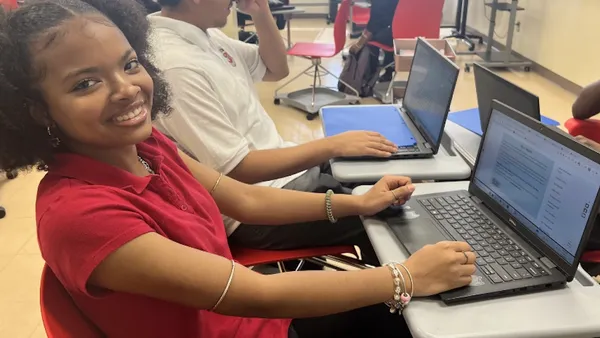Higher education institutions across the country are working to increase diversity, equity and inclusion initiatives to support all students on their campuses. To do so, they are cultivating programs and prioritizing teaching styles that acknowledge that every student is unique — and enters higher education with different needs, abilities, resources and lived experiences. One area often overlooked amid efforts to provide accessible and equitable support to students is the ability to communicate.
Communication skills are a crucial factor in achieving better academic and professional outcomes. Yet not all institutions treat communication as a diversity, equity and inclusion challenge. Whether students attend class in person or virtually, have unique learning needs, are beginning their higher education journey later in life or are arriving fresh out of high school, the ability to communicate clearly and effectively is at the forefront of success in the classroom and, eventually, the workplace.
By reconsidering how communication skills are emphasized and fostered in higher education, institutions can level the playing field and meet students where they are by offering equitable communication support.
Here are three ways institutions can help nurture students’ ability to communicate clearly and, by doing so, contribute to better outcomes for students of every background.
1. Educate students on why communication skills matter
The shift to remote or virtual experiences in both academic and professional settings during the COVID-19 pandemic has made having sharp writing skills even more critical. With less opportunity to rely on in-person interactions, students need strong communication skills to convey questions and needs and express their understanding of the curriculum to their instructors. As educational institutions and professional workplaces embrace hybrid models for the future, the ability to communicate across a range of topics and circumstances will continue to be critical to success.
“No matter how strong a student’s grasp of a subject, they have to be able to articulate their knowledge and opinions by formulating persuasive writing to show mastery of a topic,” said Dorian Stone, head of organizations revenue at Grammarly, an AI-powered writing assistant used by millions of students and trusted by over 3,000 institutions to improve communication.
“So much of the actual value of what an individual can bring into the classroom or the workplace is filtered through their ability to communicate.”
Research supports this. In a study conducted by NACE, nearly three-quarters of employers said they seek out college graduates with excellent written communication skills, yet a separate study conducted by the AACU found that only 44% of employers believe graduates are well-prepared to write effectively. To set students up for professional success, institutions need to stress the importance of communication skills and focus on helping students strengthen them as they prepare to launch their careers.
2. Make improved writing skills a priority across all areas of study
Writing matters in all career paths and areas of study — not just in English, journalism or other similarly focused courses. Students who can communicate effectively in writing can improve their ability to recall information, enhance their critical thinking skills, organize and make connections between different concepts and ultimately be prepared to put their credentials to use. While written communication is a top skill sought by employees hiring college grads, Grammarly’s recent study found that an overwhelming 92% of educators say students struggle with writing confidence.
We all know the adage that “practice makes perfect.” That’s why encouraging instructors to implement additional writing opportunities and point students to digital resources that offer writing support can help emphasize the value of robust communication.
Here are four ways to seamlessly incorporate writing instruction into any program of study:
-
Assign group projects with a writing component in all subjects — including those like STEM that might not traditionally include it — to boost group writing skills, which nearly 93% of educators surveyed by Grammarly saw as a struggle. A top concern is that basic grammar rules are often ignored. Rather than simply correcting grammatical errors, Grammarly enhances student learning by explaining the rationale behind the error and how each suggestion improves their writing.
-
Rather than supply all classroom materials, encourage students to flex their writing muscles by taking notes during class.
-
Highlight a question of the week online and offer extra credit for students who respond. This will encourage students to express themselves and their knowledge more reflectively and help instructors get to know them better as individuals with unique experiences and perspectives.
-
Review proper source citations and offer tools and examples to help students avoid unintentional plagiarism. Grammarly’s plagiarism detector helps to ensure academic integrity by catching passages that may need citation.
3. Establish your institution as a source of equal access
Students from different backgrounds have had to navigate vastly different levels of support, resources and instruction and, in many cases, the COVID-19 pandemic exacerbated the existing divide in academics. Now, the onus is on institutions to level the playing field by providing access to resources that students might not otherwise have. For example, when schools transitioning to remote learning realized some students lacked access to digital tools, they found ways to bridge the gap and took creative steps like adding Wi-Fi to outdoor public spaces and providing loaner laptops and hot spots.
Whether they’re facing economic struggles, time constraints or other challenges, not all students are set up for success the way they should be. Providing institution-wide access to technology and resources that support communication can lead to increased equity in the student body. When students have the support they need to write effectively, educators can focus on clarity and content rather than on the mechanics of grammar, resulting in a more equitable learning environment and greater student success.
“Communication is the filter through which the world evaluates the value and total potential of our contributions. The more effectively a student can communicate, the better the world will be able to see their true value and potential — which translates to better engagement and success during their time at the institution and beyond,” said Stone.
What effort is your institution making to level the playing field?
Striving for equitable access across the institution entails looking at equity through different lenses. As you assess the communication support your institution offers, consider whether you’re providing resources that meet the needs of all students. Where are there communication gaps and how can you strengthen the support you offer?
On-demand, digital-first tools like Grammarly level the playing field and empower all students to improve their communication skills. With Grammarly for Education, your entire institution gains access to an AI-powered writing assistant that offers suggestions to augment classroom instruction. Receiving real-time writing feedback on every assignment, all students can feel comfortable expressing themselves through writing and feel confident that they’re submitting their best work.
Download Grammarly’s newest ebook to continue exploring the critical role higher education institutions play in equipping students with communication skills. In the ebook, Grammarly shares five steps higher education institutions can take to advocate for equity and ensure all students have the skills and tools they need to communicate effectively.










